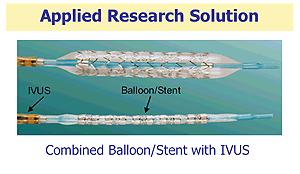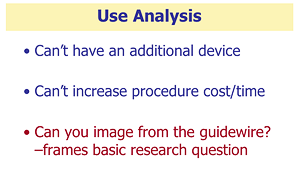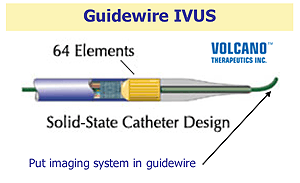|
|
So it was not the flaming success we thought. What was the applied-research approach to this? Well, the first was, if you gotta pull a device out and stick another one in, let's combine the therapeutic device with this imaging device. We'll have one device, and that's what this is. This was developed in the late '90s; you can see it's a stent. That's the metallic—one of the older metallic stents, not the drug-eluding newer stents—a metallic stent delivered along a balloon, and it has the little imaging system. We were real excited about this until a marketing person, after going through a few clinical trials, noted that this is really great, but it costs twice as much.
It turns out that there was little cost savings by integrating these two technologies, so again, the development of this took it from 7 percent just a few years ago up to about 10 percent today. It's not going further with this. So use analysis. Remember, use-inspired research. What's the analysis that we had out of this? One, we can't have an additional device. Whatever you do, you can't make a new gadget to go in there. Second, you can't increase the procedure cost or time because these folks are cowboys.
Unless it's the most difficult case, they're just going to do it blind. They'd rather do it blind than have the extra procedure cost, as long as they know it's not a difficult or complicated case, at least from the beginning, The cowboys can always go back, if they see some complication, and use it as they refine the procedure, but in the initial case, they won't do it. So what we came up with about 10 years ago was a framing of question: Instead of imaging from the device, can you image from the guidewire?
Well, what is the guidewire? Here's this picture of one of these devices. This is an imaging device. That little wire is about 300 microns in diameter; actually it's smaller than that because it's one-fifth of the diameter of this guy, which means it's about 1/25th the area of the actual catheter that's snaked down there because you deliver these devices back and forth. The way we framed the question was, can we just stick the imaging system in the guidewire? That way, whatever device comes in and out, we're there with our imaging system looking all the time. From the time that you go into the cath lab to the time you leave the cath lab, when the wire's in there, you're imaging and looking there all the time.
>
01 02 03 04 05 06 07 08 09 10 11 12 13 14 15 16 17 18 19
|
|



|
